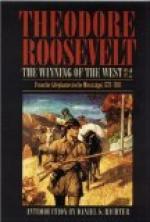The Americans were discovered by their foes when only a quarter of a mile away. They had formed their forces as they marched. The right centre was composed of Campbell’s troops; the left centre of Shelby’s. These two bodies separated slightly so as to come up opposite sides of the narrow southwestern spur of the mountain. The right wing was led by Sevier, with his own and McDowell’s troops. On the extreme right Major Winston, splitting off from the main body a few minutes before, had led a portion of Cleavland’s men by a roundabout route to take the mountain in the rear, and cut off all retreat. He and his followers “rode like fox-hunters,” as was afterwards reported by one of their number who was accustomed to following the buck and the gray fox with horn and hound. They did not dismount until they reached the foot of the mountain, galloping at full speed through the rock-strewn woods; and they struck exactly the right place, closing up the only gap by which the enemy could have retreated. The left wing was led by Cleavland. It contained not only the bulk of his own Wilkes and Surrey men, but also the North and South Carolinians who had joined the army at the Cowpens under the command of Williams, Lacey, Hambright, Chronicle, and others. [Footnote: Draper gives a good plan of the battle. He also gives some pictures of the fighting, in which the backwoodsmen are depicted in full Continental uniform, which probably not a man—certainly very few of them—wore.] The different leaders cheered on their troops by a few last words as they went into the fight; being especially careful to warn them how to deal with the British bayonet charges. Campbell had visited each separate band, again requesting every man who felt like flinching not to go into the battle. He bade them hold on to every inch of ground as long as possible, and when forced back to rally and return at once to the fight. Cleavland gave much the same advice; telling his men that when once engaged they were not to wait for the word of command, but to do as he did, for he would show them by his example how to fight, and they must then act as their own officers. The men were to fire quickly, and stand their ground as long as possible, if necessary sheltering themselves behind trees. If they could do no better they were to retreat, but not to run quite off; but to return and renew the struggle, for they might have better luck at the next attempt. [Footnote: Ramsay ("Revolution in South Carolina"), writing in 1785, gives the speech verbatim, apparently from Cleavland himself. It is very improbable that it is verbally correct, but doubtless it represents the spirit of his remarks.]




